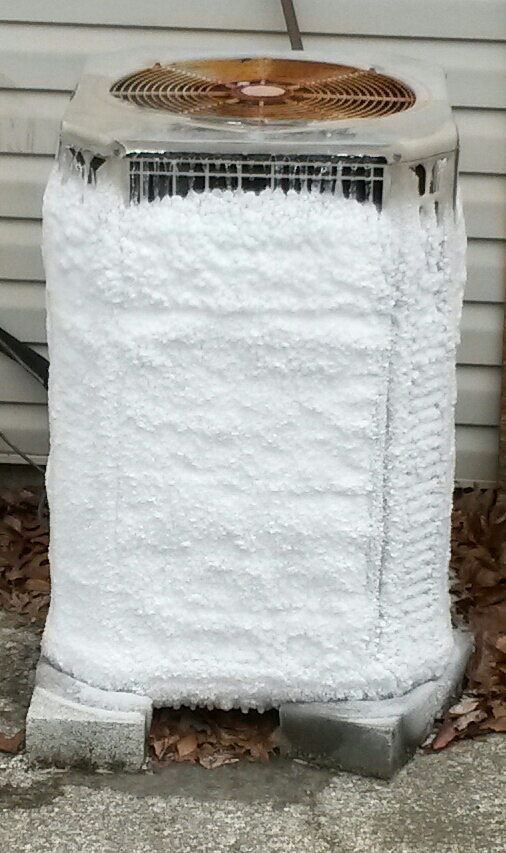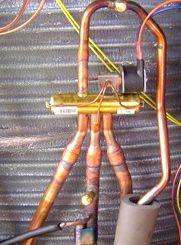Why Does My Heat Pump Frost Over?

The outdoor unit† of a heat pump (that metal noisemaker that disturbs the peace on so many otherwise nice summer afternoons) will occasionally grow frost around the outside of the unit when it’s in heating mode. Is this OK? If so, how much is OK? What about the amount of frost on the unit in this photo?
Yes, a little bit of frost on the heat pump’s outdoor unit is normal. No, the amount of frost you see above is not OK.
Why does it happen?
It’s just the science of phase changes. Outdoor air—yes, even cold, dry outdoor air—has some water vapor in it. Air with water vapor in it has a dew point, the temperature at which the water vapor changes phase and becomes a liquid. When that outdoor air finds a surface that’s at a temperature below its dew point, the water vapor condenses out of it. If that surface and the surrounding air are below the freezing point as well, the condensed water freezes.
All that depends on the outdoor air and the temperature of the heat pump condenser. The refrigerant in a heat pump typically runs 10 to 20 degrees Fahrenheit colder than the outdoor air. If that temperatures happens to be below the dew point of the air and below the freezing point, you get frost. The typical conditions for this to occur are when the outdoor air temperature is below 40° F and the relative humidity is about 70% or higher. As the temperature drops below 20° F, the chance of frost on the heat pump diminishes.
As I write this, heat pumps in Atlanta may well be frosting up a bit. The temperature is 39° F and the RH is 65%.
How much frost is too much?
If you see a little bit of frost forming, check back in a while and see if it’s still there. Heat pumps have a defrost cycle that melts frost that builds up. The defrost cycle simply changes the direction of flow so that the hot refrigerant doesn’t take its heat indoors but instead goes back  through the outdoor coil. The fan in the outdoor unit stops to keep cold air from hindering the defrosting process.
through the outdoor coil. The fan in the outdoor unit stops to keep cold air from hindering the defrosting process.
A little bit of frost is OK as long as it disappears after a while. If you see so much frost on the unit that air cannot pass through the fins on the outdoor unit, as in the photo above, or if frost stays on the coil for a two hours or more, then something is wrong. It could be the defrost controls, the reversing valve (shown in photo at right), or improper refrigerant level. If frost forms on the outdoor unit and stays there, it’s time to call your HVAC company and have them repair the system.
A teaser
The defrost cycle on a heat pump can use a lot of energy. When the refrigerant flows backwards to defrost the outdoor coil, it’s not heating the house. In fact, without supplemental heat, your system will blow cold air into your home. Most heat pumps have supplemental heat, though, and most of the time it’s electric resistance heat. In the defrost cycle, your supplemental heat kicks in and you pay more.
But how smart is the defrost system on your heat pump? Does it go into defrost mode only when necessary? Or does it cycle on and off even when it doesn’t need to? Stay tuned. I’ll have another article about heat pumps, the defrost cycle, and energy consumption soon!
Addendum: Here’s that followup article: Why Are Heat Pumps So Dumb About Frost?
Allison A. Bailes III, PhD is a speaker, writer, building science consultant, and the founder of Energy Vanguard in Decatur, Georgia. He has a doctorate in physics and writes the Energy Vanguard Blog. He also has written a book on building science. You can follow him on Twitter at @EnergyVanguard.
Related Articles
How the Heck Does a Heat Pump Get Heat from Cold?!
Dew Point — A More Meaningful Measure of Humidity?
The Shocking Truth About Heat Pumps
Photo courtesy of Josh Littrell of the East Kentucky Power Cooperative.
Footnote
† Unfortunately, many people refer to the outdoor unit as the condensing unit. Yes, that’s what it is when it’s running in cooling mode, but in heating mode, that’s where the evaporation happens. In winter, that metal noisemaker should be called the evaporating unit. Calling it the outdoor unit works in all seasons. For an introductory explanation of the refrigeration cycle, which moves heat between indoors and outdoors, see my article, The Magic of Cold.
This Post Has 5 Comments
Comments are closed.

I recall having to pour hot
I recall having to pour hot water on my first heat pump (circa 1979). That unit was a dog compared to today’s heat pumps.
Typically, defrost initiation is based on a timer (30, 45, 90 minutes, set depending on local climate). The key for intelligent defrost control is the ability to stay in defrost mode long enough to remove most of the build-up, while ending defrost cycles quickly when there’s not enough moisture to form frost. This is typically done with a temperature sensor on the liquid line.
In my dry (Arizona) climate, the defrost only operates about 20 seconds (except those rare occasions when we actually have some moisture in the air), so there’s little impact on efficiency. In fact, I have my strips disabled and never notice the momentary loss of heat in the supply air stream.
Here’s a picture of a different problem. Freezing rain accumulated overnight on top when the unit didn’t cycle on in the hours after setback. Plus I think the gutters may have been clogged.
Nice job! This was a great
Nice job! This was a great way to simplify a complex subject for the lay-person. (Although my jaw did drop when I saw the amount of ice on that heat pump). Heck you could do a whole series from this: The importance of proper heat pump maintenance, equipment and line-set sizing, installation and charging, issues due to improper airflow, freezing of indoor coils, etc.
Sorry – didn’t mean to get excited and create more work for you 😉
I’m looking forward to the
I’m looking forward to the article about smarter defrost controls.
I prefer to refer to the box outside as the “outdoor unit” or even “compressor section” to avoid the inaccuracy of “condensing unit” during heating mode.
Around the time Atlanta had a 2″ snowfall blizzard, Jacksonville experienced a rare condition – 35 degrees combined with rain (i.e. 100% RH. Defrost controls were taxed as never before.
Thanks for the footnote about
Thanks for the footnote about “condensing units”, Allison. That word bugs me every time when the topic is heat pumps.
David B.:
David B.: I’ll give you a hint. Mike MacFarland’s intelligent defrost system measures pressure as well as using the built-in timer and temperature sensor.
Adam G.: Thanks! I’ve covered some of those topics already and will have an article about Mike MacFarland’s intelligent defrost system out soon, next week I hope.
Curt K.: Yeah, I usually say ‘outdoor unit’ when I’m talking about heat pumps, too, but for some reason used condensing unit here and clarified with the footnote. Also, see my response to David Butler above for a hint about Mike MacFarland’s intelligent defrost system.
Jehan: Thanks!
John S.: Yes, it’s bugged me, too. I probably should’ve used ‘outdoor unit’ instead. In fact, I think I’ll go change it now.